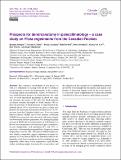Files in this item
Prospects for dendroanatomy in paleoclimatology - a case study on Picea engelmannii from the Canadian Rockies
Item metadata
| dc.contributor.author | Seftigen, Kristina | |
| dc.contributor.author | Fonti, Marina V. | |
| dc.contributor.author | Luckman, Brian | |
| dc.contributor.author | Rydval, Miloš | |
| dc.contributor.author | Stridbeck, Petter | |
| dc.contributor.author | Von Arx, Georg | |
| dc.contributor.author | Wilson, Rob | |
| dc.contributor.author | Björklund, Jesper | |
| dc.date.accessioned | 2023-03-23T16:30:13Z | |
| dc.date.available | 2023-03-23T16:30:13Z | |
| dc.date.issued | 2022-05-24 | |
| dc.identifier | 283822614 | |
| dc.identifier | ba3ac41f-56e7-4871-9057-63f03cf10ee7 | |
| dc.identifier | 85131050603 | |
| dc.identifier.citation | Seftigen , K , Fonti , M V , Luckman , B , Rydval , M , Stridbeck , P , Von Arx , G , Wilson , R & Björklund , J 2022 , ' Prospects for dendroanatomy in paleoclimatology - a case study on Picea engelmannii from the Canadian Rockies ' , Climate of the Past , vol. 18 , no. 5 , pp. 1151-1168 . https://doi.org/10.5194/cp-18-1151-2022 | en |
| dc.identifier.issn | 1814-9324 | |
| dc.identifier.other | ORCID: /0000-0003-4486-8904/work/131588259 | |
| dc.identifier.uri | https://hdl.handle.net/10023/27254 | |
| dc.description | Funding: This research was supported by the Svenska Forskningsrådet Formas (grant no. 2019-01482), the National Science Foundation (grant no. 1502150), the Schweizerischer Nationalfonds zur Förderung der Wissenschaftlichen Forschung (grant no. 200021_182398), and the Grantová Agentura České Republiky (grant no. 20-22351Y). | en |
| dc.description.abstract | The continuous development of new proxies as well as a refinement of existing tools are key to advances in paleoclimate research and improvements in the accuracy of existing climate reconstructions. Herein, we build on recent methodological progress in dendroanatomy, the analyses of wood anatomical parameters in dated tree rings, and introduce the longest (1585-2014CE) dendroanatomical dataset currently developed for North America. We explore the potential of dendroanatomy of high-elevation Engelmann spruce (Picea engelmannii) as a proxy of past temperatures by measuring anatomical cell dimensions of 15 living trees from the Columbia Icefield area. X-ray maximum latewood density (MXD) and its blue intensity counterpart (MXBI) have previously been measured, allowing comparison between the different parameters. Our findings highlight anatomical MXD and maximum radial cell wall thickness as the two most promising wood anatomical proxy parameters for past temperatures, each explaining 46% and 49%, respectively, of detrended instrumental July-August maximum temperatures over the 1901-1994 period. While both parameters display comparable climatic imprinting at higher frequencies to X-ray derived MXD, the anatomical dataset distinguishes itself from its predecessors by providing the most temporally stable warm season temperature signal. Further studies, including samples from more diverse age cohorts and the adaptation of the regional curve standardization method, are needed to disentangle the ontogenetic and climatic components of long-term signals stored in the wood anatomical traits and to more comprehensively evaluate the potential contribution of this new dataset to paleoclimate research. | |
| dc.format.extent | 18 | |
| dc.format.extent | 9256311 | |
| dc.language.iso | eng | |
| dc.relation.ispartof | Climate of the Past | en |
| dc.subject | GE Environmental Sciences | en |
| dc.subject | Global and Planetary Change | en |
| dc.subject | Stratigraphy | en |
| dc.subject | Palaeontology | en |
| dc.subject | NDAS | en |
| dc.subject | MCC | en |
| dc.subject.lcc | GE | en |
| dc.title | Prospects for dendroanatomy in paleoclimatology - a case study on Picea engelmannii from the Canadian Rockies | en |
| dc.type | Journal article | en |
| dc.contributor.institution | University of St Andrews. School of Earth & Environmental Sciences | en |
| dc.contributor.institution | University of St Andrews. Scottish Oceans Institute | en |
| dc.contributor.institution | University of St Andrews. St Andrews Sustainability Institute | en |
| dc.identifier.doi | 10.5194/cp-18-1151-2022 | |
| dc.description.status | Peer reviewed | en |
This item appears in the following Collection(s)
Items in the St Andrews Research Repository are protected by copyright, with all rights reserved, unless otherwise indicated.

